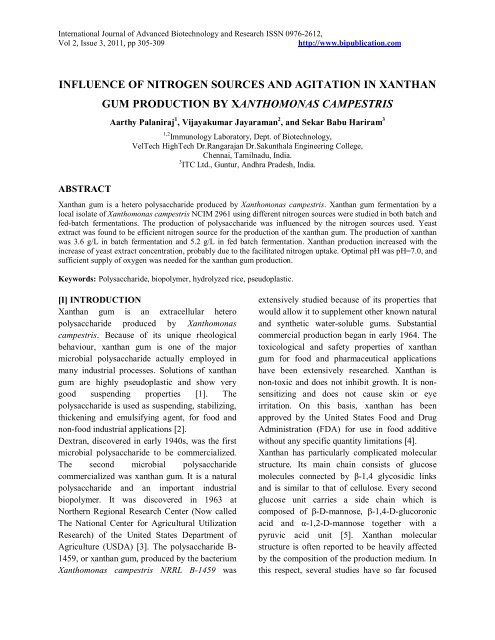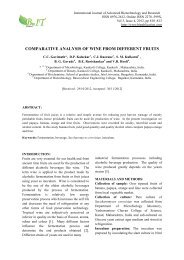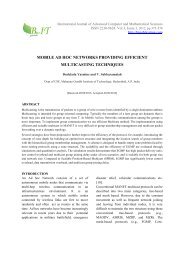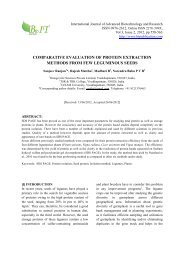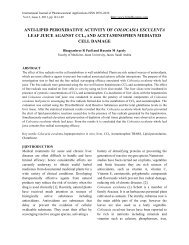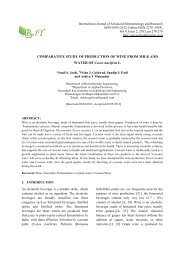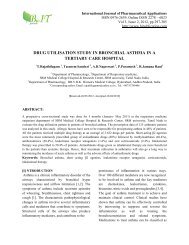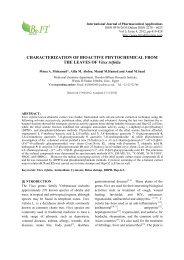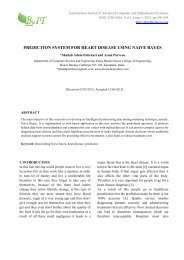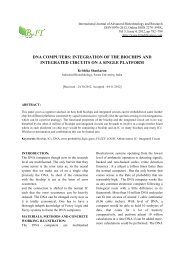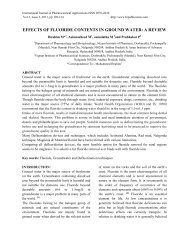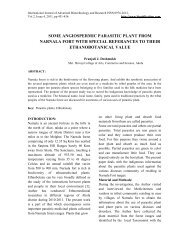influence of nitrogen sources and agitation in xanthan gum - BioIT ...
influence of nitrogen sources and agitation in xanthan gum - BioIT ...
influence of nitrogen sources and agitation in xanthan gum - BioIT ...
You also want an ePaper? Increase the reach of your titles
YUMPU automatically turns print PDFs into web optimized ePapers that Google loves.
International Journal <strong>of</strong> Advanced Biotechnology <strong>and</strong> Research ISSN 0976-2612,Vol 2, Issue 3, 2011, pp 305-309http://www.bipublication.comINFLUENCE OF NITROGEN SOURCES AND AGITATION IN XANTHANGUM PRODUCTION BY XANTHOMONAS CAMPESTRISAarthy Palaniraj 1 , Vijayakumar Jayaraman 2 , <strong>and</strong> Sekar Babu Hariram 31,2 Immunology Laboratory, Dept. <strong>of</strong> Biotechnology,VelTech HighTech Dr.Rangarajan Dr.Sakunthala Eng<strong>in</strong>eer<strong>in</strong>g College,Chennai, Tamilnadu, India.3 ITC Ltd., Guntur, Andhra Pradesh, India.ABSTRACTXanthan <strong>gum</strong> is a hetero polysaccharide produced by Xanthomonas campestris. Xanthan <strong>gum</strong> fermentation by alocal isolate <strong>of</strong> Xanthomonas campestris NCIM 2961 us<strong>in</strong>g different <strong>nitrogen</strong> <strong>sources</strong> were studied <strong>in</strong> both batch <strong>and</strong>fed-batch fermentations. The production <strong>of</strong> polysaccharide was <strong><strong>in</strong>fluence</strong>d by the <strong>nitrogen</strong> <strong>sources</strong> used. Yeastextract was found to be efficient <strong>nitrogen</strong> source for the production <strong>of</strong> the <strong>xanthan</strong> <strong>gum</strong>. The production <strong>of</strong> <strong>xanthan</strong>was 3.6 g/L <strong>in</strong> batch fermentation <strong>and</strong> 5.2 g/L <strong>in</strong> fed batch fermentation. Xanthan production <strong>in</strong>creased with the<strong>in</strong>crease <strong>of</strong> yeast extract concentration, probably due to the facilitated <strong>nitrogen</strong> uptake. Optimal pH was pH=7.0, <strong>and</strong>sufficient supply <strong>of</strong> oxygen was needed for the <strong>xanthan</strong> <strong>gum</strong> production.Keywords: Polysaccharide, biopolymer, hydrolyzed rice, pseudoplastic.[I] INTRODUCTIONXanthan <strong>gum</strong> is an extracellular heteropolysaccharide produced by Xanthomonascampestris. Because <strong>of</strong> its unique rheologicalbehaviour, <strong>xanthan</strong> <strong>gum</strong> is one <strong>of</strong> the majormicrobial polysaccharide actually employed <strong>in</strong>many <strong>in</strong>dustrial processes. Solutions <strong>of</strong> <strong>xanthan</strong><strong>gum</strong> are highly pseudoplastic <strong>and</strong> show verygood suspend<strong>in</strong>g properties [1]. Thepolysaccharide is used as suspend<strong>in</strong>g, stabiliz<strong>in</strong>g,thicken<strong>in</strong>g <strong>and</strong> emulsify<strong>in</strong>g agent, for food <strong>and</strong>non-food <strong>in</strong>dustrial applications [2].Dextran, discovered <strong>in</strong> early 1940s, was the firstmicrobial polysaccharide to be commercialized.The second microbial polysaccharidecommercialized was <strong>xanthan</strong> <strong>gum</strong>. It is a naturalpolysaccharide <strong>and</strong> an important <strong>in</strong>dustrialbiopolymer. It was discovered <strong>in</strong> 1963 atNorthern Regional Research Center (Now calledThe National Center for Agricultural UtilizationResearch) <strong>of</strong> the United States Department <strong>of</strong>Agriculture (USDA) [3]. The polysaccharide B-1459, or <strong>xanthan</strong> <strong>gum</strong>, produced by the bacteriumXanthomonas campestris NRRL B-1459 wasextensively studied because <strong>of</strong> its properties thatwould allow it to supplement other known natural<strong>and</strong> synthetic water-soluble <strong>gum</strong>s. Substantialcommercial production began <strong>in</strong> early 1964. Thetoxicological <strong>and</strong> safety properties <strong>of</strong> <strong>xanthan</strong><strong>gum</strong> for food <strong>and</strong> pharmaceutical applicationshave been extensively researched. Xanthan isnon-toxic <strong>and</strong> does not <strong>in</strong>hibit growth. It is nonsensitiz<strong>in</strong>g<strong>and</strong> does not cause sk<strong>in</strong> or eyeirritation. On this basis, <strong>xanthan</strong> has beenapproved by the United States Food <strong>and</strong> DrugAdm<strong>in</strong>istration (FDA) for use <strong>in</strong> food additivewithout any specific quantity limitations [4].Xanthan has particularly complicated molecularstructure. Its ma<strong>in</strong> cha<strong>in</strong> consists <strong>of</strong> glucosemolecules connected by β-1,4 glycosidic l<strong>in</strong>ks<strong>and</strong> is similar to that <strong>of</strong> cellulose. Every secondglucose unit carries a side cha<strong>in</strong> which iscomposed <strong>of</strong> β-D-mannose, β-1,4-D-glucoronicacid <strong>and</strong> α-1,2-D-mannose together with apyruvic acid unit [5]. Xanthan molecularstructure is <strong>of</strong>ten reported to be heavily affectedby the composition <strong>of</strong> the production medium. Inthis respect, several studies have so far focused
INFLUENCE OF NITROGEN SOURCES AND AGITATION IN XANTHAN GUMon a variety <strong>of</strong> nutrients, particularly the <strong>nitrogen</strong><strong>and</strong> carbon <strong>sources</strong>, with glucose <strong>and</strong> sucrose asthe most frequently used carbon <strong>sources</strong> [6,7].Most commercial production method for <strong>xanthan</strong><strong>gum</strong> uses glucose or <strong>in</strong>vert sugars, <strong>and</strong> most<strong>in</strong>dustries prefer batch processes than cont<strong>in</strong>uousprocesses [8]. Other substrates have also beentested, such as sucrose, hydrolyzed rice, barley,corn flour, acid whey, sugar cane molasses,coconut juice, sugar cane, etc., but glucose is stillthe best <strong>in</strong> terms <strong>of</strong> product yield, supply, <strong>and</strong>product quality [5, 9-11]. It has been found thatthe production <strong>and</strong> the properties <strong>of</strong> <strong>xanthan</strong> <strong>gum</strong>are <strong><strong>in</strong>fluence</strong>d by bacterial stra<strong>in</strong> [12-13], culturemedium [8, 14-15], temperature [16-17], pH [18],time <strong>of</strong> fermentation [19], <strong>and</strong> <strong>agitation</strong> rate [20-21].The purpose <strong>of</strong> this study was to optimize the<strong>xanthan</strong> <strong>gum</strong> production by Xanthomonascampestris with respect to <strong>nitrogen</strong> <strong>sources</strong> <strong>and</strong>effect <strong>of</strong> <strong>agitation</strong>.[II] MATERIALS AND METHODS2.1. Microorganism <strong>and</strong> <strong>in</strong>oculum preparationXanthomonas campestris NCIM 2961 wasobta<strong>in</strong>ed from NCIM, Pune, <strong>and</strong> used throughoutthis study. The stra<strong>in</strong> was ma<strong>in</strong>ta<strong>in</strong>ed on nutrientagar slant conta<strong>in</strong><strong>in</strong>g (g/L) glucose 10; Maltextract 3; Yeast extract 3; <strong>and</strong> Peptone 5; pH=7grown at 30 °C for 24 hours <strong>and</strong> stored at 4 °C.Actively grow<strong>in</strong>g cells from a newly preparedslant were <strong>in</strong>oculated <strong>in</strong>to the liquid medium <strong>in</strong>250 ml Erlenmeyer flask. The culture was<strong>in</strong>cubated at 30-35 °C for 24 hours <strong>in</strong> an<strong>in</strong>cubator shaker. The liquid culture was used to<strong>in</strong>oculate the f<strong>in</strong>al fermentation medium.2.2. Fermentation experimentsAll the fermentation experiments were conducted<strong>in</strong> a 2L bioreactor (Biostat-B, Sartorius,Germany). The production medium wascomposed <strong>of</strong> glucose (25 g/L), yeast extract (3.0g/L), KH 2 PO 4 (2.0 g/L), MgSO 4 (1.0 g/L) <strong>and</strong>antifoam agent (0.1 mL/L). The fermentationmedium without the carbon source was sterilized<strong>in</strong> the fermentation vessel. The carbon source wassterilized separately <strong>and</strong> then aseptically<strong>in</strong>troduced <strong>in</strong>to the vessel. Dur<strong>in</strong>g fermentationruns, the dissolved oxygen concentration wasma<strong>in</strong>ta<strong>in</strong>ed at 10-30 % <strong>of</strong> saturation value by<strong>in</strong>creas<strong>in</strong>g the stirrer speed as needed, whilekeep<strong>in</strong>g constant 1 vvm (air volume/mediumvolume/m<strong>in</strong>ute) airflow rate. Temperature wasma<strong>in</strong>ta<strong>in</strong>ed constant at 28 °C for 24 h. The pH <strong>of</strong>the medium was held at pH=7.0 by add<strong>in</strong>g 1 MHCl/1M NaOH. Dur<strong>in</strong>g the process, theconcentrations <strong>of</strong> the cells, glucose, <strong>and</strong> <strong>xanthan</strong><strong>gum</strong> were measured <strong>in</strong> the culture medium <strong>in</strong> fivesamples <strong>of</strong> 50 mL each. All fermentation runswere conducted <strong>in</strong> triplicate.2.3. Determ<strong>in</strong>ation <strong>of</strong> biomass <strong>and</strong> <strong>xanthan</strong><strong>gum</strong> concentrationThe fermentation broth produced by the batchprocesses were diluted us<strong>in</strong>g distilled water tolower the viscosity, <strong>and</strong> then 20 mL aliquots weretransferred <strong>in</strong>to micro centrifuge tubes. Themicro-centrifuge tubes conta<strong>in</strong><strong>in</strong>g aliquots werecentrifuged at 10,000 rpm for 30 m<strong>in</strong>utes at 4 °C.After centrifugation, two fractions were formed,supernatant conta<strong>in</strong><strong>in</strong>g <strong>xanthan</strong> <strong>gum</strong>, <strong>and</strong> biomassdeposited as a pellet. The biomass pellet wasresuspended with water for wash<strong>in</strong>g <strong>and</strong> thenrecentrifuged to reprecipitate the biomass. Thebiomass deposited at the bottom <strong>of</strong> tubes wasdried <strong>in</strong> the oven at 60 °C for two hours <strong>and</strong>weighed to get the dry mass to show the relativeperformance <strong>of</strong> the cotton fibre <strong>in</strong> reta<strong>in</strong><strong>in</strong>g thecells. Supernatants were mixed with 2/3 (v/v)isopropanol, re-centrifuged at 10,000 rpm for 45m<strong>in</strong>utes at 4 °C to completely precipitate <strong>xanthan</strong><strong>gum</strong> before remov<strong>in</strong>g the solvent <strong>and</strong> water fromthe top portion. The precipitated <strong>xanthan</strong> <strong>gum</strong>collected from all samples was dried overnight <strong>in</strong>the oven at 50 to60 °C <strong>in</strong> the pre weighed micro-centrifuge tube.Aarthy Palaniraj et al. 306
INFLUENCE OF NITROGEN SOURCES AND AGITATION IN XANTHAN GUMThe concentration <strong>of</strong> <strong>xanthan</strong> <strong>gum</strong> wasdeterm<strong>in</strong>ed as the dry weight <strong>of</strong> <strong>xanthan</strong> <strong>gum</strong> perlitre culture medium.[III] RESULTS AND DISCUSSION3.1. Effect <strong>of</strong> <strong>nitrogen</strong> <strong>sources</strong>Xanthomonas campestris NCIM 2961 wascultivated <strong>in</strong> the medium conta<strong>in</strong><strong>in</strong>g various<strong>nitrogen</strong> <strong>sources</strong> such as urid dhal, toor dhal,green gram, soybean meal <strong>and</strong> yeast extract.When the cells were grown <strong>in</strong> the yeast extractconta<strong>in</strong><strong>in</strong>g medium, the <strong>xanthan</strong> production (3.6g/L) was the highest among those tested shown <strong>in</strong>[Figiure-1]. The <strong>xanthan</strong> produced (2.7 g/L)from urid dhal <strong>and</strong> the other <strong>nitrogen</strong> <strong>sources</strong> wasmuch lower than that from Yeast extract shown<strong>in</strong> [Table-1].Nitrogen<strong>sources</strong>Xanthan <strong>gum</strong>yield (g/L)Biomassproduction(g/L)Urid dhal 2.8 6.2Toor dhal 2.1 6.3Green gram 2.4 6.5Soybean meal 2.5 5.3Yeast extract 3.6 5.6Table 1. Yield <strong>of</strong> <strong>xanthan</strong> <strong>gum</strong> from various <strong>nitrogen</strong><strong>sources</strong> by batch fermentationFig. 1. Effect <strong>of</strong> <strong>nitrogen</strong> <strong>sources</strong> on <strong>xanthan</strong> <strong>gum</strong>production by Batch fermentationWe further exam<strong>in</strong>ed the effect <strong>of</strong> <strong>nitrogen</strong>concentration on the <strong>xanthan</strong> production s<strong>in</strong>cethere have been reported broad ranges <strong>of</strong> optimalconcentration depend<strong>in</strong>g on the microorganisms.It is <strong>in</strong>terest<strong>in</strong>g to see that the maximum <strong>xanthan</strong>production obta<strong>in</strong>ed at 30 g/L as the <strong>in</strong>itial yeastextract concentration <strong>in</strong>creased from 10 to 40 g/Lshown <strong>in</strong> [Figure-2].Fig. 2. Effect <strong>of</strong> Agitation on Xanthan <strong>gum</strong>production3.2. Effect <strong>of</strong> <strong>agitation</strong>The k<strong>in</strong>etics <strong>of</strong> growth <strong>and</strong> <strong>xanthan</strong> production byXanthomonas campestris NCIM 2961 <strong>in</strong> batchculture was studied <strong>in</strong> laboratory fermenter.Fermentations were carried out over a range <strong>of</strong>stirrer speeds from 100 to 600 rpm, whichcovered the entire range <strong>of</strong> stirrer speeds practicalfor the bioreactor used. [Figure-3] shows thefermentation carried out at 300 to 600 rpm. Celldryweight, <strong>and</strong> <strong>xanthan</strong> concentration arepresented over a time course <strong>of</strong> 72 h. Increased<strong>agitation</strong> levels resulted <strong>in</strong> higher productionlevels <strong>xanthan</strong> production almost doubled as thestirrer speed <strong>in</strong>creased from 300 to 600 rpm <strong>and</strong>similar was the effect on cell growth. Growth <strong>and</strong>production were low <strong>and</strong> rather similar for thetwo lower speeds <strong>of</strong> 300 <strong>and</strong> 400 rpm. Xanthanproduction appeared slightly higher at the end <strong>of</strong>fermentation (72 h) at 400 rpm compared withAarthy Palaniraj et al. 307
INFLUENCE OF NITROGEN SOURCES AND AGITATION IN XANTHAN GUM300 rpm production levels on <strong>in</strong>creas<strong>in</strong>g thestirrer speed beyond 400 rpm, <strong>xanthan</strong> productionappeared to depend on <strong>agitation</strong>, withsignificantly <strong>in</strong>creas<strong>in</strong>g concentrations with<strong>in</strong>creased stirrer speeds. The optimum <strong>agitation</strong>was found to be at 500 rpm <strong>and</strong> the yield <strong>of</strong><strong>xanthan</strong> was 3.62 g/L.Fig. 3. Xanthan <strong>gum</strong> yield <strong>and</strong> biomass productionfrom yeast extract3.3. Batch fermentationTo exam<strong>in</strong>e the pattern <strong>of</strong> the <strong>xanthan</strong> production<strong>in</strong> detail, batch fermentations were carried out <strong>in</strong>a jar fermentor. [Figure-1] shows the yield<strong>xanthan</strong> <strong>gum</strong> from various <strong>nitrogen</strong> <strong>sources</strong> used<strong>in</strong> batch fermentation at 500 rpm. The yeastextract gave the maximum production <strong>of</strong> <strong>xanthan</strong>,3.6 g/L at 500 rpm. Xanthan production showedthe same pr<strong>of</strong>ile with the cell growth. It was alsonoted that no further <strong>xanthan</strong> was produced after<strong>nitrogen</strong> <strong>sources</strong> were exhausted <strong>and</strong> the yeastextract concentration fell below 40 g/L shown <strong>in</strong>[Table-2].Yeast extract Xanthan <strong>gum</strong> Biomassconcentration yield (g L -1 ) production(g/L)(g/L)1 3.0 5.22 2.6 4.53 3.6 5.64 2.9 4.5Table 2. Yield <strong>of</strong> <strong>xanthan</strong> <strong>gum</strong> <strong>and</strong> biomassproduction from yeast extract3.4. Fed-batch fermentationResults obta<strong>in</strong>ed from the batch cultivation led usto carry out a fed-batch fermentation to promotethe <strong>xanthan</strong> production by add<strong>in</strong>g glucose <strong>and</strong>yeast extract before they decl<strong>in</strong>ed at certa<strong>in</strong>concentrations. Dissolved oxygen concentrationwas also ma<strong>in</strong>ta<strong>in</strong>ed above 10 % air saturationdur<strong>in</strong>g the <strong>xanthan</strong> production by shift-up the<strong>agitation</strong> speed. Cell concentration <strong>and</strong> <strong>xanthan</strong>concentration cont<strong>in</strong>ued to <strong>in</strong>crease whensufficient <strong>nitrogen</strong> <strong>and</strong> carbon were supplied. Theyield <strong>of</strong> <strong>xanthan</strong> <strong>gum</strong> produced from fed batchfermentation was 5.2 g/L. In the fed batch mode<strong>of</strong> fermentation the addition <strong>of</strong> substrates atregular <strong>in</strong>tervals improved the xathan production.This was due to the reduction/elim<strong>in</strong>ation <strong>of</strong>catabolite repression due to the controlled feed<strong>in</strong>g<strong>of</strong> substrate which would otherwise had turned onthe fermentative path way lead<strong>in</strong>g to fermentativeproducts because <strong>of</strong> excess <strong>of</strong> glucose <strong>in</strong> themedium.[IV] CONCLUSIONThe optimization <strong>and</strong> production <strong>of</strong> the <strong>xanthan</strong><strong>gum</strong> with different <strong>nitrogen</strong> <strong>sources</strong> such as theurid dhal, toor dhal, green gram <strong>and</strong> yeast extractwere compared <strong>and</strong> yeast extract showed highest<strong>xanthan</strong> <strong>gum</strong> production <strong>of</strong> 0.36 g/100 mL whileUrid dhal gave 0.27g/100 mL, toor dhal gave0.22g/100 mL, <strong>and</strong> green gram gave 0.21g/100mL.Different <strong>agitation</strong> speed such as 300 rpm, 400rpm, 500 rpm, <strong>and</strong> 600 rpm was optimized for<strong>xanthan</strong> <strong>gum</strong> production with yeast extract <strong>and</strong>the optimum production was found at 500 rpm.References1. Milas M, Reed WF, Pr<strong>in</strong>tz S, [1996]Conformations <strong>and</strong> flexibility <strong>of</strong> native <strong>and</strong> renatured<strong>xanthan</strong> <strong>in</strong> aqueous solutions, Int. J. Biol.Macromol. 18:211-221.2. Sutherl<strong>and</strong> IW, [1996] Extracellularpolysaccharides. In: Biotechnology, vol 6, 2 nd ed.,(Rehm HJ <strong>and</strong> G Reed, Eds.) VCH, We<strong>in</strong>heim,pp. 613-657Aarthy Palaniraj et al. 308
INFLUENCE OF NITROGEN SOURCES AND AGITATION IN XANTHAN GUM3. Margaritis A, Zajic JE, [1978] Biotechnologyreview: mix<strong>in</strong>g mass transfer <strong>and</strong> scale-up <strong>of</strong>polysaccharide fermentations, Biotechnol. Bioeng.20: 939-1001.4. Kennedy JF, Bradshaw IJ, [1984] Production,properties <strong>and</strong> applications <strong>of</strong> <strong>xanthan</strong>, Prog. Ind.Microbiol. 19: 319-371.5. Rosalam S, Engl<strong>and</strong> R, [2006] Review <strong>of</strong> <strong>xanthan</strong><strong>gum</strong> production from unmodified starches byXanthomonas camprestris sp, Enzyme Microb.Technol. 39: 197-207.6. Garcia-Ochoa F, Gomez E, [1998] Mass transfercoefficient <strong>in</strong> stirred reactors for <strong>xanthan</strong> <strong>gum</strong>solutions, Biochem. Eng. 1:1-10.7. Garcia-Ochoa F, Santos VE, Casas JA, Gomez E,[2000] Xanthan <strong>gum</strong>: Production, recovery, <strong>and</strong>properties, Biotechnol. Adv. 18:549-579.8. Letisse F, Chevallereau P, Simon JL, L<strong>in</strong>dley ND,[2001] K<strong>in</strong>etic analysis <strong>of</strong> growth <strong>and</strong> <strong>xanthan</strong><strong>gum</strong> production with Xanthomonas comprestrison sucrose, us<strong>in</strong>g sequentially consumed <strong>nitrogen</strong><strong>sources</strong>, Appl. Microbiol. Biotechnol. 55:417-422.9. El-Salam MHA, Fadel MA, Murad HA, [1994]Bioconversion <strong>of</strong> sugarcane molasses <strong>in</strong>to <strong>xanthan</strong><strong>gum</strong>, J. Biotechnol. 33:103-106.10. Garcia-Ochoa F, Santos VE, Alcon A, [2004]Chemical structured k<strong>in</strong>etic model for <strong>xanthan</strong>production. Enzyme Microb. Technol. 35:284-292.11. Kongruang S, [2005] Growth k<strong>in</strong>etics <strong>of</strong> <strong>xanthan</strong>production from uneconomical agriculturalproducts with Xanthomonas campestris TISTR1100, J. Appl. Sci. 4(2):78-88.12. Rodriguez H, Aguilar L, [1997] Detection <strong>of</strong>Xanthomonas campestris mutants with <strong>in</strong>creased<strong>xanthan</strong> production, J. Ind. Microbiol. Biochem.18(4):232-234.13. Moreira AS, Vendruscolo JLS, Gil-Turnes C,Vendruscolo CT, [2001] Screen<strong>in</strong>g among 18novel stra<strong>in</strong>s <strong>of</strong> Xanthomonas campestris pvpruni, Food Hydrocol. 15:469-474.14. Amanullah AS, Satti S, Nienow AW, [1998]Enhanc<strong>in</strong>g <strong>xanthan</strong> fermentations by differentmodes <strong>of</strong> glucose feed<strong>in</strong>g, Biotechnol. Prog.14:265-269.15. Garcia-Ochoa F, Santos VE, Fritsch AP, [1992]Nutritional study <strong>of</strong> Xanthomonas campestris <strong>in</strong><strong>xanthan</strong> <strong>gum</strong> production by factorial design <strong>of</strong>experiments. Enzyme Microb. Technol. 14:991-997.16. Shu CH, Yang ST, [1990] Effect <strong>of</strong> temperatureon cell growth <strong>and</strong> <strong>xanthan</strong> production <strong>in</strong> batchculture <strong>of</strong> Xanthomonas campestris, Biotechnol.Bioeng. 35:454-468.17. Shu CH, Yang ST, [1991] K<strong>in</strong>etics <strong>and</strong> model<strong>in</strong>g<strong>of</strong> temperature effects on batch <strong>xanthan</strong> <strong>gum</strong>fermentation, Biotechnol. Bioeng. 37:567-574.18. Esgalhado ME, Roseiro JC, Amaral CMT, [1995]Interactive effects <strong>of</strong> pH <strong>and</strong> temperature on cellgrowth <strong>and</strong> polymer production by Xanthomonascampestris, Process Biochem. 30(7):667-671.19. Cacik F, Dondo RG, Marques D, [2001] Optimalcontrol <strong>of</strong> a batch bioreactor for the production <strong>of</strong><strong>xanthan</strong> <strong>gum</strong>, Comput. Chem. Eng. 25:409-418.20. Amanullah A, Tuttiett B, Nienow AW, [1998]Agitator speed <strong>and</strong> dissolved oxygen effects <strong>in</strong><strong>xanthan</strong> fermentations, Biotechnol. Bioeng.57(2):198-210.21. Peters HU, Herbst H, Hessel<strong>in</strong>k PGM, LunsdorfH, Schumpe A, Deckwer WD, [ 1989] The<strong><strong>in</strong>fluence</strong> <strong>of</strong> <strong>agitation</strong> rate on <strong>xanthan</strong> productionby Xanthomonas campestris, Biotechnol. Bioeng.34:1393-1397.Aarthy Palaniraj et al. 309


